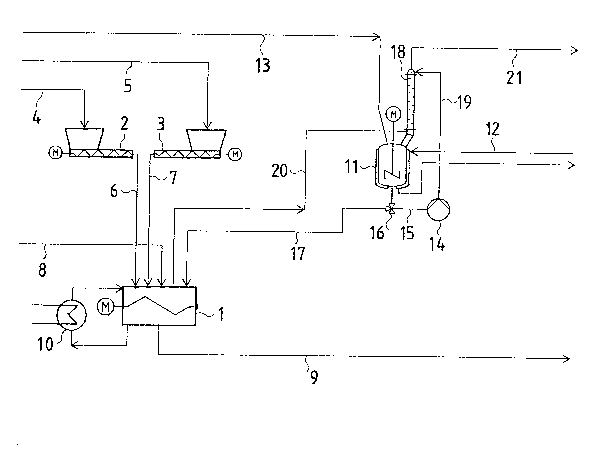Some of the information on this Web page has been provided by external sources. The Government of Canada is not responsible for the accuracy, reliability or currency of the information supplied by external sources. Users wishing to rely upon this information should consult directly with the source of the information. Content provided by external sources is not subject to official languages, privacy and accessibility requirements.
Any discrepancies in the text and image of the Claims and Abstract are due to differing posting times. Text of the Claims and Abstract are posted:
| (12) Patent Application: | (11) CA 2046841 |
|---|---|
| (54) English Title: | PROCESS AND PLANT FOR THE PREPARATION OF AMMONIUM POLYPHOSPHATE |
| (54) French Title: | PROCEDE ET INSTALLATIONS DESTINES A LA PREPARATION DE POLYPHOSPHATE D'AMMONIUM |
| Status: | Deemed Abandoned and Beyond the Period of Reinstatement - Pending Response to Notice of Disregarded Communication |
| (51) International Patent Classification (IPC): |
|
|---|---|
| (72) Inventors : |
|
| (73) Owners : |
|
| (71) Applicants : |
|
| (74) Agent: | SMART & BIGGAR LP |
| (74) Associate agent: | |
| (45) Issued: | |
| (22) Filed Date: | 1991-07-11 |
| (41) Open to Public Inspection: | 1992-02-01 |
| Availability of licence: | N/A |
| Dedicated to the Public: | N/A |
| (25) Language of filing: | English |
| Patent Cooperation Treaty (PCT): | No |
|---|
| (30) Application Priority Data: | ||||||
|---|---|---|---|---|---|---|
|
HOE 90/H 021
Process and plant for the preparation of ammonium
polyphosphate
Abstract of the disclosure:
To prepare essentially water-insoluble, chain-form
ammonium polyphosphate from equimolar amounts of di-
ammonium phosphate and phosphorus pentoxide in the
presence of ammonia at temperatures of from 170 to 350°C
with constant mixing, kneading and comminution, at least
some of the diammonium phosphate and phosphorus pentoxide
is replaced by partially ammoniated polyphosphoric acid.
A plant for carrying out this process can comprise a
sealed reactor (l) which is provided with metering
devices (2, 3) and feed tubes (4, 5) for phosphorus
pentoxide and diammonium orthophosphate, an ammonia feed
tube (8), an ammonium polyphosphate discharge tube (9)
and a line for offgas. Rotatable mixing r kneading and
comminution elements are provided inside the reactor (1).
Furthermore, a heatable stirred tank (11) which can be
charged with polyphosphoric acid via a feed line (13) is
provided and can be used to remove water vapor and
ammonia from the offgas flowing from the reactor (1) via
the line (20) and from which partially ammoniated poly-
phosphoric acid can be introduced into the reactor (1)
via an outlet line (17).
Note: Claims are shown in the official language in which they were submitted.
Note: Descriptions are shown in the official language in which they were submitted.

2024-08-01:As part of the Next Generation Patents (NGP) transition, the Canadian Patents Database (CPD) now contains a more detailed Event History, which replicates the Event Log of our new back-office solution.
Please note that "Inactive:" events refers to events no longer in use in our new back-office solution.
For a clearer understanding of the status of the application/patent presented on this page, the site Disclaimer , as well as the definitions for Patent , Event History , Maintenance Fee and Payment History should be consulted.
| Description | Date |
|---|---|
| Inactive: IPC from MCD | 2006-03-11 |
| Deemed Abandoned - Failure to Respond to Maintenance Fee Notice | 1999-07-12 |
| Inactive: Dead - RFE never made | 1999-07-12 |
| Application Not Reinstated by Deadline | 1999-07-12 |
| Inactive: Abandon-RFE+Late fee unpaid-Correspondence sent | 1998-07-13 |
| Application Published (Open to Public Inspection) | 1992-02-01 |
| Abandonment Date | Reason | Reinstatement Date |
|---|---|---|
| 1999-07-12 |
The last payment was received on 1998-05-28
Note : If the full payment has not been received on or before the date indicated, a further fee may be required which may be one of the following
Please refer to the CIPO Patent Fees web page to see all current fee amounts.
| Fee Type | Anniversary Year | Due Date | Paid Date |
|---|---|---|---|
| MF (application, 6th anniv.) - standard | 06 | 1997-07-11 | 1997-07-09 |
| MF (application, 7th anniv.) - standard | 07 | 1998-07-13 | 1998-05-28 |
Note: Records showing the ownership history in alphabetical order.
| Current Owners on Record |
|---|
| HOECHST AKTIENGESELLSCHAFT |
| Past Owners on Record |
|---|
| RENATE ADRIAN |
| THOMAS STAFFEL |
| WOLFGANG BECKER |